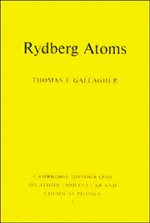Book contents
- Frontmatter
- Contents
- Preface
- 1 Introduction
- 2 Rydberg atom wavefunctions
- 3 Production of Rydberg atoms
- 4 Oscillator strengths and lifetimes
- 5 Black body radiation
- 6 Electric fields
- 7 Pulsed field ionization
- 8 Photoexcitation in electric fields
- 9 Magnetic fields
- 10 Microwave excitation and ionization
- 11 Collisions with neutral atoms and molecules
- 12 Spectral line shifts and broadenings
- 13 Charged particle collisions
- 14 Resonant Rydberg–Rydberg collisions
- 15 Radiative collisions
- 16 Spectroscopy of alkali Rydberg states
- 17 Rf spectroscopy of alkaline earth atoms
- 18 Bound He Rydberg states
- 19 Autoionizing Rydberg states
- 20 Quantum defect theory
- 21 Optical spectra of autoionizing Rydberg states
- 22 Interseries interaction in bound states
- 23 Double Rydberg states
- Index
7 - Pulsed field ionization
Published online by Cambridge University Press: 29 September 2009
- Frontmatter
- Contents
- Preface
- 1 Introduction
- 2 Rydberg atom wavefunctions
- 3 Production of Rydberg atoms
- 4 Oscillator strengths and lifetimes
- 5 Black body radiation
- 6 Electric fields
- 7 Pulsed field ionization
- 8 Photoexcitation in electric fields
- 9 Magnetic fields
- 10 Microwave excitation and ionization
- 11 Collisions with neutral atoms and molecules
- 12 Spectral line shifts and broadenings
- 13 Charged particle collisions
- 14 Resonant Rydberg–Rydberg collisions
- 15 Radiative collisions
- 16 Spectroscopy of alkali Rydberg states
- 17 Rf spectroscopy of alkaline earth atoms
- 18 Bound He Rydberg states
- 19 Autoionizing Rydberg states
- 20 Quantum defect theory
- 21 Optical spectra of autoionizing Rydberg states
- 22 Interseries interaction in bound states
- 23 Double Rydberg states
- Index
Summary
Because it can be efficient and selective, field ionization of Rydberg atoms has become a widely used tool. Often the field is applied as a pulse, with rise times of nanoseconds to microseconds, and to realize the potential of field ionization we need to understand what happens to the atoms as the pulsed field rises from zero to the ionizing field. In the previous chapter we discussed the ionization rates of Stark states in static fields. In this chapter we consider how atoms evolve from zero field states to the high field Stark states during the pulse. Since the evolution depends on the risetime of the pulse, it is impossible to describe all possible outcomes. Instead, we describe a few practically important limiting cases.
Although we are not concerned here with the details of how to produce the pulses, it is worth noting that several different types of pulse, having the time dependences shown in Fig. 7.1, have been used. Fig. 7.1(a) depicts a pulse which rises rapidly to a plateau. Atoms in a fast beam experience this sort of pulse when passing into a region of high homogenous field. Fig. 7.1(b) shows a rapidly rising pulse which decays rapidly after reaching its peak. While not elegant, such pulses are easily produced. For pulse shapes such as those of Figs. 7.1 (a) and (b) the ability to discriminate between different states comes mostly from adjustment of the amplitude of the pulse.
- Type
- Chapter
- Information
- Rydberg Atoms , pp. 103 - 119Publisher: Cambridge University PressPrint publication year: 1994

